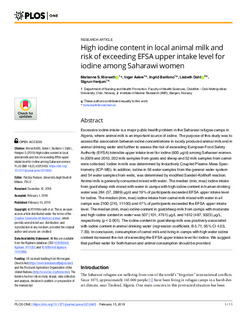High iodine content in local animal milk and risk of exceeding EFSA upper intake level for iodine among Saharawi women
Journal article, Peer reviewed
Published version
Permanent lenke
http://hdl.handle.net/11250/2600101Utgivelsesdato
2019Metadata
Vis full innførselSamlinger
- Articles [3011]
- Publikasjoner fra CRIStin [3061]
Sammendrag
Excessive iodine intake is a major public health problem in the Saharawi refugee camps in Algeria, where animal milk is an important source of iodine. The purpose of this study was to assess the association between iodine concentrations in locally produced animal milk and in animal drinking water and further to assess the risk of exceeding European Food Safety Authority (EFSA) tolerable upper intake level for iodine (600 μg/d) among Saharawi women. In 2009 and 2010, 202 milk samples from goats and sheep and 52 milk samples from camel were collected. Iodine in milk was determined by Inductively Coupled Plasma-Mass Spectrometry (ICP-MS). In addition, iodine in 56 water samples from the general water system and 54 water samples from wells, was determined by modified Sandell-Kolthoff reaction. Animal milk is generally consumed mixed with water. The median (min, max) iodine intake from goat/sheep milk mixed with water in camps with high iodine content in human drinking water was 284 (57, 2889) μg/d and 19% of participants exceeded EFSA upper intake level for iodine. The median (min, max) iodine intake from camel milk mixed with water in all camps was 2100 (210, 11100) and 47% of participants exceeded the EFSA upper intake level. The median (min, max) iodine content in goat/sheep milk from camps with moderate and high iodine content in water was 507 (101, 4791) μg/L and 1612 (487, 9323) μg/L, respectively (p < 0.001). The iodine content in goat/sheep milk was positively associated with iodine content in animal drinking water (regression coefficient, B 5.71, 95% CI 4.03, 7.39). In conclusion, consumption of camel milk and living in camps with high water iodine content increased the risk of exceeding the EFSA upper intake level for iodine. We suggest that purified water for both human and animal consumption should be provided.
